Review Graphing Before Teaching Linear Systems
The week before Thanksgiving we finished our unit on writing linear equations in all its forms. After a week off, I know I will need to review these concepts before plunging ahead to begin our unit on Linear Systems.
Monday we will review graphing linear systems written in Slope-Intercept form. I plan to use an idea from a recent training. It focuses on multiple representations (my interpretation) and having students work in pairs to match up graphs to equations, except that there is an uneven match.
Group Review Activity for Linear Systems
For instance:


![]()
![]()
![]()
The students should be able to identify slope and y-intercept, write the equation in slope-intercept form and then translate that into standard form. I thought about having them graph the equation that is left-over but that seems a little much for the first day back.
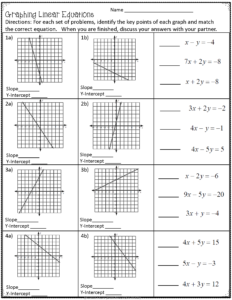
I will work through one of the problem sets with the students, thinking out loud as I go so the ideas of slope, y-intercept, standard form, and slope-intercept form are reviewed. Once we have reviewed, it will be their turn to work through the problems and identify the equations that match the graphs.
Introduce Linear Systems with a Group Activity
This review will introduce graphing linear systems in a very natural way. Last year, I used the transparency method to have students graph linear systems the first day and identify solutions. The prep is easy, copy a coordinate plane onto transparencies (make sure they are safe to put in a printer or copy machine or they may melt), and have students each graph one equation.


For the equations, I just printed out a few worksheets with the equations printed in both standard form and slope-intercept form. Cut the worksheets apart and let students draw an equation
Then they match up their graph with others, identify the solution to the linear system. They have to record each other’s equations (for use another day) and then move on to other students. This cuts down on those slow graphers (you know the ones, who spend the entire period graphing one equation) and focus on identifying solutions. I do collect the papers at the end, mark and return the next day to have students verify the solutions by substituting back in the system.
Graphing/No Graphing

I have spent less time actually graphing, and more class time having students to identify key points in graphs. With limited time in the classroom (and a lot of absent students) I try to use my time efficiently as well as pack as much in as possible.
Using a group activity like this also gives students processing time to understand what a system looks like and finding solutions using a low-stress approach. You can see how effective it is in this picture, which is very clear in person. Yes, since the students pick an equation at random, it is possible that some of the solutions are not graphing friendly. That will be an excellent teaching point the next day when we review solutions and debrief.

I also cannot predict how many problems they will get through. Some of my students suffer from “it’s not finished’ syndrome. So I try to provide more than they can finish so there is some sense of urgency in getting their work done.
I also have a lot of interruptions during a class.
Using Flip Books for Linear Systems Notes
 After these review activities, I will use a flip book for notes on Linear Systems. Students love them and it fits nicely into their interactive notebook. When I first started teaching, I used a lot of flip books and for some reason thought I needed to do the whole book at once.
After these review activities, I will use a flip book for notes on Linear Systems. Students love them and it fits nicely into their interactive notebook. When I first started teaching, I used a lot of flip books and for some reason thought I needed to do the whole book at once.
These days I will do a page a day. I did a class in brain development in teens a few summers ago. For my at-risk students, they can only focus on 8-10 minutes at a time, so I keep the notes simple and direct, then proceed to practice of some type.
Students like the quick notes, feel successful with smaller bites of content and like getting to the practice. Our practice is rarely a worksheet. OK, it is usually a worksheet, but I disguise it as something else. Even when we use a worksheet directly, I call it by some crazy name and explain it as a game. If you tell a student they are playing a game, and declare a winner, they are all in.
More Ideas for Activities
I really enjoy teaching linear systems, and depending on the students, I mix it up with a lot of activities.
www.teacherdesmos.com has several activities for students if you have access to student devices. You can set up the code through Google Classroom or just write it on the board. I love setting up things in Google Classroom. And when a student is absent, they just need to check the links out for the days they missed.
I would suggest anytime you use an activity in the classroom, you try it out first without students. I cannot count how many times I tried to “wing it” with some activity or idea and got totally lost.
Boom Cards are digital task cards. No prep, engaging to students and excellent formative assessment for teachers. Click the image to learn more.
The sequence activity is a quick assessment and practice for students to match graphs to systems. Students begin with the first piece in the sequence, then join them in order until finished. I usually cut the pieces myself for students to assemble, but students can cut (but it takes reallllly loooong). Click image to learn more.
I like using the Odd Man Out activity to help students identify those items that do not belong with the group. I use this as a warm up during the linear systems unit.
Resource also includes teaching page, so teachers can demonstrate one of the pages with the students before students attempt a page on their own. Click image to learn more.
Linear Equation Maze.
The nice thing about using this maze set is that it works well as a sub-plan. Once students are familiar with a maze, they do not need further directions. The first time a maze is used each year in a class, I have to be very specific about solving and drawing the path thru the maze. Otherwise, the students will just try to solve all the problems and ignore the correct solutions given.
There are 6 different versions, and the first one requires students to identify solutions from a graph. The other versions require a mix of solving methods for linear systems.
Solving Linear Systems with Substitution
I love partner activities. Students have different problems but they have the same answers. Each student has to do their own work, but they can check their answers with a partner. Both substitution and elimination methods for linear systems are used. And includes exit tickets for an assessment.
Solving Linear Systems with Elimination
This is a double set. The first version requires students to solve the system and match with the correct solution. Good partner activity.
I like using the version with 2 systems that have the same solution. I put students in groups for this, they are all solving systems and finding solutions. When all the systems are solved, they match up those with the same solution. Great self-checking activity. Once students are finished matching up, any odd systems that are un-matched need further checking.
Boom Cards are a great assessment for teachers and offers immediate feedback for students. You can set up your class and students can log in anywhere for additional practice.
When I first started using these cards in the classroom, I had students ask me if they could log on at home and keep practicing. I thought someone was pranking me. Never before had students ASKED ME if they could do more math.
If you have free Friday, try this free resources. Students mix up the pieces and draw 4 each. The person with start goes first, then whoever has the system/solution to the first piece goes next. This continues until all pieces have been played.
If you enjoy the free version, try the full version with 4 different sets of dominoes. Includes an 8 piece, 12 piece, 16 piece, and 24 piece set. Have the students solve and then make a poster of their solutions.
Word Problems
Practicing with word problems can be fun. Students work in groups to solve each system. Correct answers give a piece to the 9-piece puzzle. When the puzzle is complete, solve the additional problem and students win. Ok, I don’t know what they win, but my students like stuff when they win.
Anyway, this is my sneaky math approach working again. It seems like a game, there are rules and there is a winner. So it is fun.
Holiday Systems
I could not resist another holiday riddle. This one is for systems, three different versions.
I am saving this for a sub-day. I have jury duty next week. Happy Holidays to me.
So check out some of these ideas and see if one of them gives your students an extra spark this week. As it gets closer to the holidays, we need to step up our game, increase the energy and try some sneaky math on them.
Have a great week.
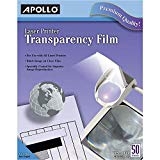

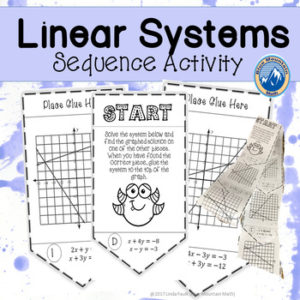





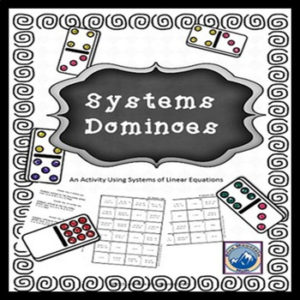

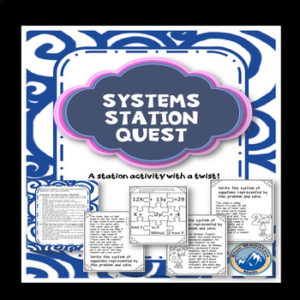











Is the flipbook you show here something you sell in your TPT store? I love the way it breaks down the methods and can’t find it anywhere!